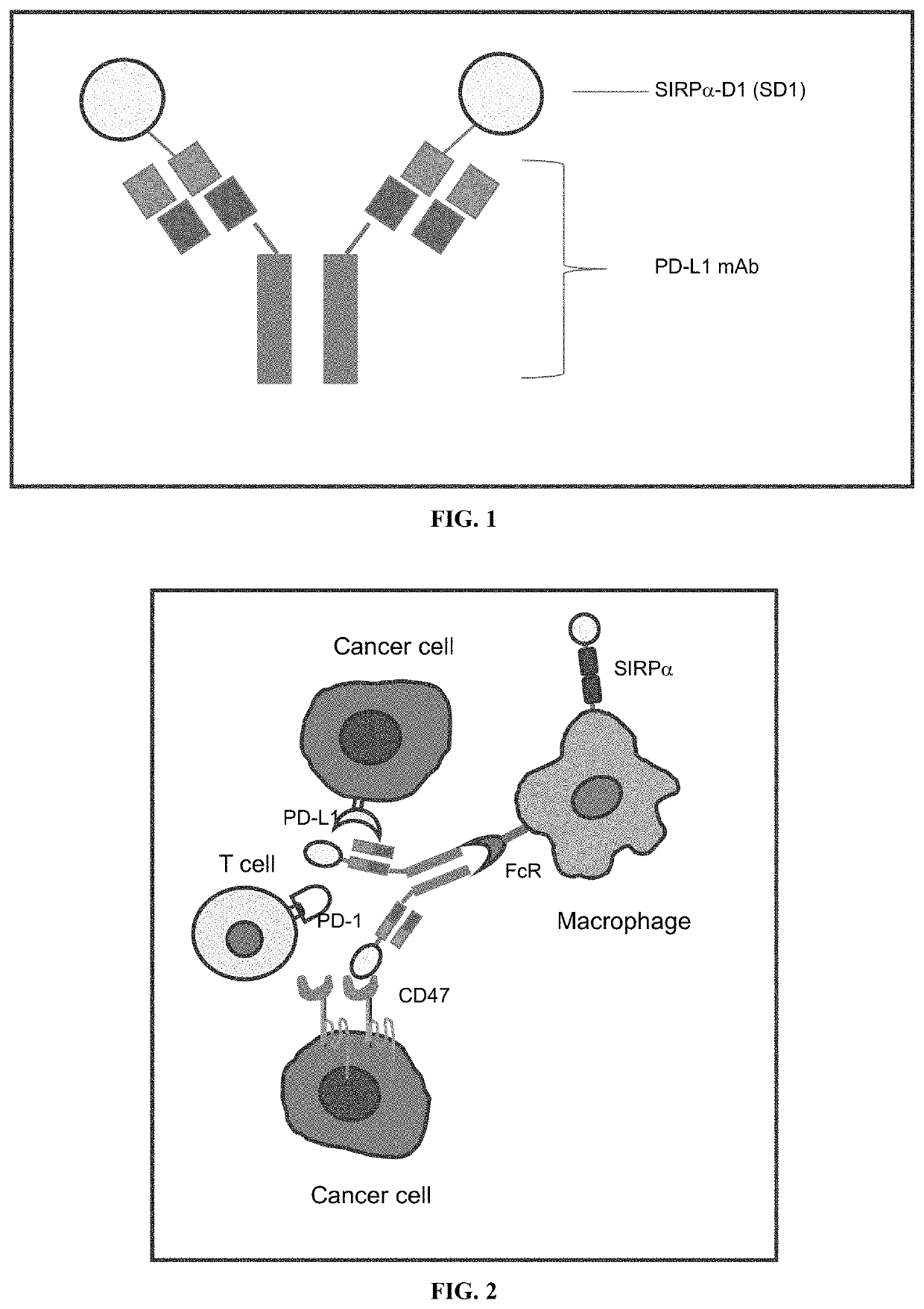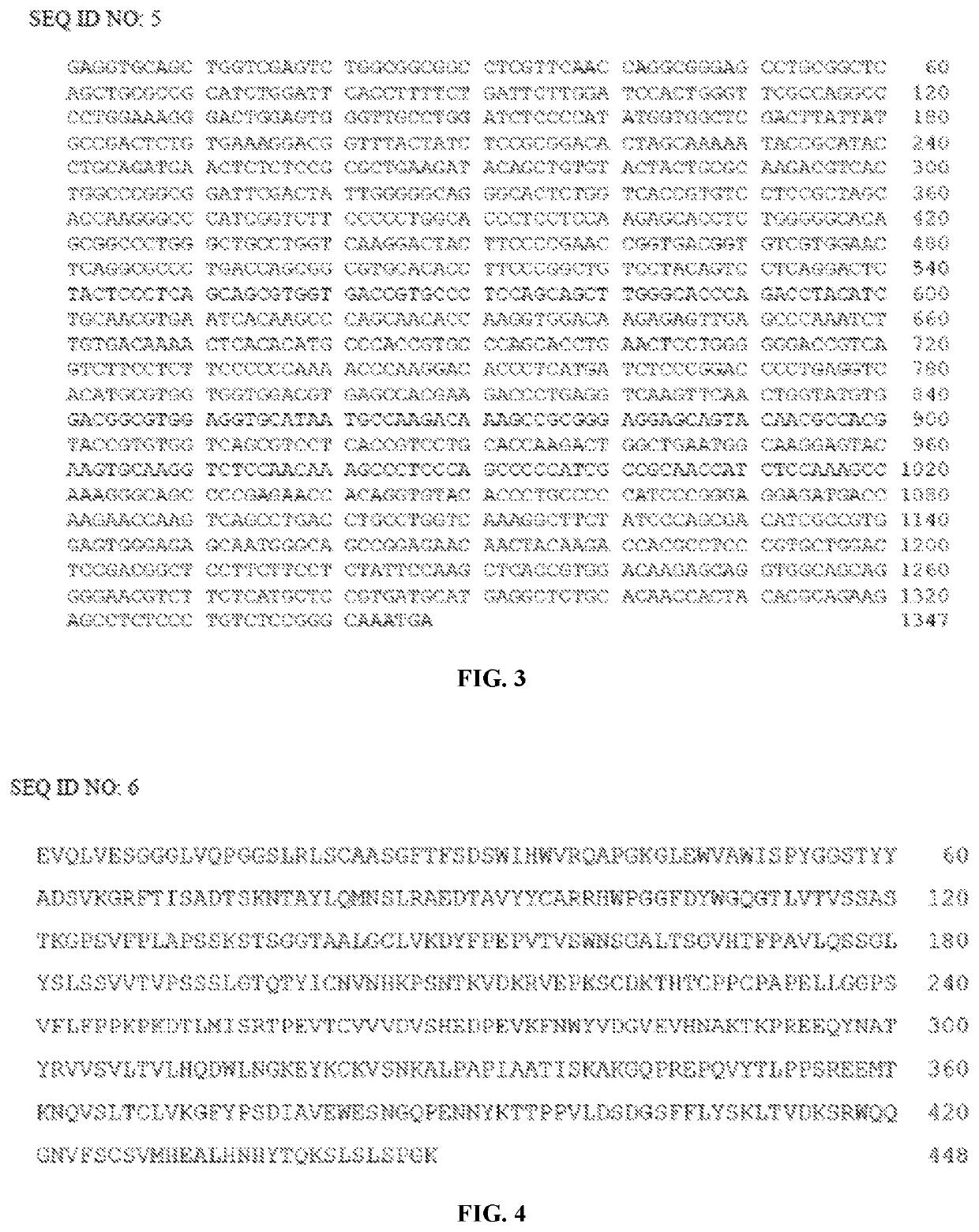Recombinant fusion protein containing an anti-PD-L1 antibody
a fusion protein and antibody technology, applied in the field of tumor therapies, can solve the problems of limited systemic treatment effectiveness of agents targeting pd-l1, increased local pd-l1, and antibodies targeting a single tumor-associated antigen, and achieve the effect of stimulating targeted cancer cell killing
- Summary
- Abstract
- Description
- Claims
- Application Information
AI Technical Summary
Benefits of technology
Problems solved by technology
Method used
Image
Examples
example 1
ion of Vectors Expressing IMM2505
[0084]Full length coding sequence of recombinant fusion protein IMM2505 was designed artificially. Specifically, for the heavy chain, the coding sequence of the first extracellular domain of SIRPα (SIRPαD1) (SEQ ID NO: 1) was linked through the GS-linker (SEQ ID NO: 3) to the N terminal of the heavy chain variable region coding sequence of IMM25 (SEQ ID NO:5). 57 nucleotides encoding the signal peptide of mouse IgG1 heavy chain (SEQ ID NO: 13) were added to the 5′ end of SIRPαD1-coding sequence, and a Kozak sequence (SEQ ID NO: 14) was added to the 5′ end of the signal peptide sequence. Lastly, HindIII and NheI restriction sites were added to the 5′ and 3′ ends of the resulting sequence, respectively. For the light chain, the same signal sequence as well as the Kozac sequence was used, but the HindIII and the XbaI restriction sites were added to the 5′ and 3′ ends of the resulting sequence, respectively. The two resulting sequences were synthesized b...
example 2
xpression and Purification
[0085]To manufacture the recombinant protein IMM2505, the expression vectors were electroporated into Chinese Hamster Ovary (CHO) cells (ATCC, Cat #CCL-61) which were subjected to several rounds of pressure selection of neomycin. The selected stable cells were adapted to a serum-free Balan CD CHO Growth A medium (Irvine Scientific, Cat #94120). For protein expression, cells were seeded in a 3 liter bioreactor and cultured in a fed-batch process. When the cell viability dropped to ˜80%, reaction in the bioreactor was terminated, the cell culture supernatant was harvested and subjected to protein purification by affinity chromatography. The purity of recombinant protein was above 95%, and the content of endotoxin was below 0.5 U / g.
example 3
ound to PD-L1 or CD47
[0086]CHO-PD-L1 cells (over expressing PD-L1) or Jurkat cells (highly expressing CD47) were incubated at 4° C. for 1 hour with serially diluted IMM2505 or control agents. Cells were washed with cold PBS two times, and then incubated with FITC-conjugated secondary antibody against human IgG-Fc (Sigma, Cat #F9512) for 45 min. Cells were washed two times and re-suspended in 200 ml of PBS. Then, the cells were subject to FACS analysis using a flow cytometer (Merck Millipore, Guava® easyCyte 5HT).
[0087]IMM2505 bound to PD-L1 on CHO cells with an EC50 value of 0.01 nM (FIG. 7), and bound to CD47 on Jurkat cells with an EC50 value of 0.04 nM (FIG. 8), a bit inferior to the traditional single antigen targeting antibodies.
PUM
| Property | Measurement | Unit |
|---|---|---|
| molecular weight | aaaaa | aaaaa |
| concentration | aaaaa | aaaaa |
| concentration | aaaaa | aaaaa |
Abstract
Description
Claims
Application Information
 Login to View More
Login to View More - R&D
- Intellectual Property
- Life Sciences
- Materials
- Tech Scout
- Unparalleled Data Quality
- Higher Quality Content
- 60% Fewer Hallucinations
Browse by: Latest US Patents, China's latest patents, Technical Efficacy Thesaurus, Application Domain, Technology Topic, Popular Technical Reports.
© 2025 PatSnap. All rights reserved.Legal|Privacy policy|Modern Slavery Act Transparency Statement|Sitemap|About US| Contact US: help@patsnap.com



